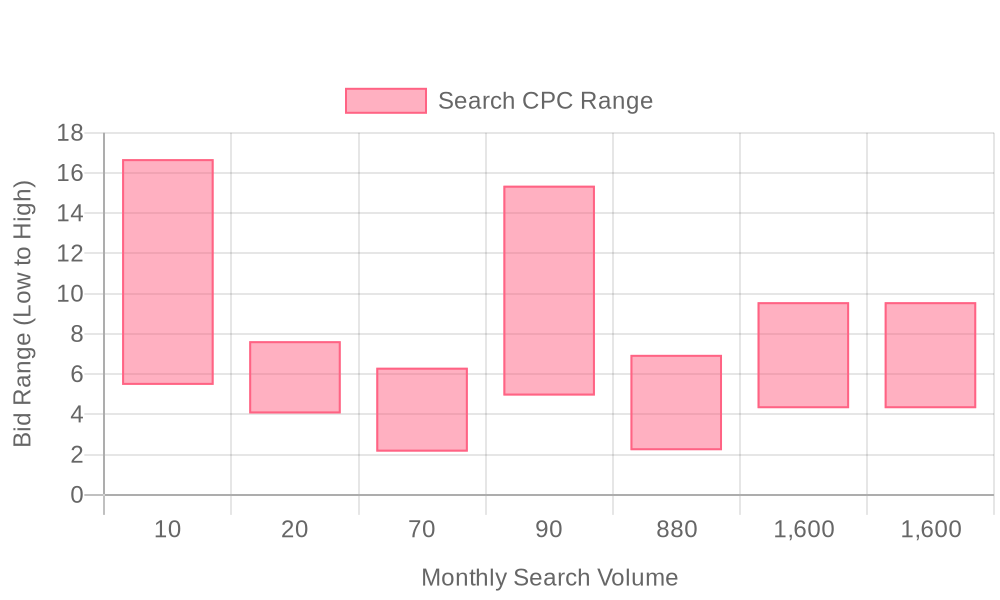
Supercharge your lead generation with a FREE Google Ads audit - no strings attached! See how you can generate more and higher quality leads
Get My Free Google Ads AuditFree consultation

No commitment
Supercharge your lead generation with a FREE LinkedIn Ads audit - no strings attached! See how you can generate more and higher quality leads
Get My Free Google Ads AuditFree consultation

No commitment
Supercharge your lead generation with a FREE Meta Ads audit - no strings attached! See how you can generate more and higher quality leads
Get My Free Google Ads AuditGet My Free LinkedIn Ads AuditGet My Free Meta Ads AuditFree consultation

No commitment
Supercharge your lead generation with a FREE Google Ads audit - no strings attached! See how you can generate more and higher quality leads
Get My Free Google Ads AuditFree consultation

No commitment
In today's fast-paced digital landscape, B2B marketing requires a precise blend of strategies across online and offline channels. For trade publications, integrating Google Ads into your promotional efforts can significantly enhance visibility and engagement. Google Ads serves as a powerful tool to target decision-makers at the exact moment they're searching for relevant content, thereby optimizing both reach and ROI. While many businesses face challenges like missing high-value prospects due to limited tracking in their CRM systems, modern tools provide solutions to surface and focus on accounts already showing purchase intent. By leveraging Google Ads strategically, trade publications can bridge the gap between their digital and print offerings, ensuring they're top of mind when readers are making purchase decisions.

Trade publications face unique challenges in building high-quality pipelines, as traditional methods often fail to capture the full spectrum of digital engagement. Leveraging advanced Google Ads strategies, these publishers can turn anonymous site visits into actionable opportunities and ultimately drive new readership, subscriptions, and advertiser interest.
A data-driven Google Ads plan for trade publications starts with understanding how campaigns fit within a broader marketing mix. Many teams struggle to identify and engage visitors who interact with editorial content but remain anonymous, missing valuable lead opportunities. Solutions like Sona Identification reveal company-level visitor data, enabling revenue teams to prioritize outreach and retargeting for high-value prospects, ensuring no potential lead is left unaddressed.
Keyword and audience targeting are the backbone of effective Google Ads for trade publications. Identifying industry-specific search terms, such as “engineering news magazine” or “supply chain publication,” improves relevance and click-through rates while minimizing wasted spend. By layering behavioral data—such as recent article reads or content downloads—marketers can refine their targeting to reach professionals who have already demonstrated genuine interest. Platforms that enrich audience segments with real-time intent signals make it possible to dynamically shift budget toward readers likely to convert, driving up campaign ROI.
Alignment between landing pages and ad creatives is pivotal for converting trade publication audiences. Crafting landing experiences that mirror ad messaging and anticipate visitor intent reduces friction and accelerates the path to subscription or inquiry. Automated workflows that respond to live engagement signals enable publishers to serve tailored content offers, immediately capitalizing on spikes in interest following major industry events or breaking news. For actionable frameworks on capturing and nurturing engaged leads, explore our playbooks for B2B marketing.
Performance optimization for trade publication ad campaigns requires continuous calibration. Predictive models can analyze historical and real-time engagement to identify accounts ready to buy, allowing for precision in budget allocation. Marketers can further increase conversion rates by using advanced attribution methods that connect ad interactions to both online and offline conversions, providing a complete view of Google Ads ROI for publications.
Trade publication marketing thrives when integrated across multiple channels. Connecting Google Ads with email, paid social, and content syndication unifies engagement data so every touchpoint works in concert. Modern solutions solve the issue of disconnected intent signals, continually syncing new leads and audience updates across Google Ads, CRM, and marketing automation systems. Using Sona Destinations ensures seamless integration for nurturing prospects efficiently, driving higher conversion rates and lifetime value.
Leading-edge platforms now automate audience building and synchronization, streamlining campaign setup and management. As audiences interact with trade content, these systems update targeting criteria and retargeting pools in real time, ensuring campaigns always reflect the latest behaviors and interests. This approach eliminates manual list uploads and reduces lag, empowering revenue teams to focus on strategy while maintaining a persistent presence with their most valuable B2B segments. Ready to transform your trade publication pipeline? Get started for free with Sona.

Trade publications operate in a high-stakes environment where reaching specialized decision-makers and industry influencers is critical for growth. Google Ads empowers publishers and B2B marketers to connect with these audiences precisely when they are actively seeking solutions, research, or new partnerships. This platform bridges the gap between print legacy and digital performance, providing a measurable, repeatable engine for lead generation and subscriber growth. For more insights on how trade publications can combine digital and print strategies, see digital and print trade publication advertising.
With closed-loop measurement, trade publication marketers can attribute conversions and revenue to specific ad interactions, both online and offline. This deep visibility not only accelerates pipeline velocity but also addresses the challenge of delayed engagement common with executive or committee-based decisions. By capturing granular touchpoints, teams gain clarity on which editorial topics, ad formats, and offers drive the highest-value leads across the funnel. To learn more about measuring marketing's impact, visit measuring marketing’s influence on the sales pipeline.
Google Ads for trade publications also unlocks strategic reach in emerging markets and specialized sectors. Publishers can deploy campaigns targeting underserved regions or newly developing industries, using location and demographic filters to ensure relevance. For anonymous website traffic—a frequent issue for B2B publishers—Sona identification enables marketers to pinpoint companies and enrich CRM records, transforming what was previously invisible into actionable opportunities.
Optimizing ad strategies for unique industry needs is essential in trade publication marketing, where buyer readiness varies and content consumption can be highly cyclical. Predictive intent data in Google Ads allows real-time budget shifts to high-converting companies or sectors, reducing wasted spend and maximizing ROI. Dynamic audience segments update automatically as readers engage with new editorial content, ensuring messaging stays targeted and relevant as prospects move from awareness to action. Discover how to create and use precise audience intelligence for more effective segmentation.
By aligning advanced tracking and CRM integration, trade publication ad campaigns gain a comprehensive view of every touchpoint. This unified data approach enables marketers to sync enriched audience lists and conversion data directly with Google Ads and major CRM platforms, streamlining follow-up and increasing the likelihood of turning high-value leads into long-term subscribers or advertising clients. If you’re ready to unify your ad and CRM strategy, get started for free with Sona.

Ready to optimize your trade publication marketing? Get started for free with Sona.

Trade publication marketing teams unlock growth by systematically identifying underserved segments within their target industries. Competitor analysis, paired with auction insights, reveals gaps in audience reach and messaging—often highlighting markets where current campaigns underperform or where rivals overlook emerging buyer groups. By layering these findings with behavior-driven data, marketers can prioritize segments that show high engagement or conversion potential, ensuring resources target the most lucrative opportunities.
Vertical keyword targeting is essential for capturing specialty service demand in trade publication advertising. Researching and deploying industry-specific keywords enables campaigns to align with real-time visitor intent, ensuring ads appear precisely when decision-makers are actively researching solutions. This approach not only increases relevance but also helps surface content to users that may not find their way through organic search alone, giving trade publications an edge in crowded digital spaces. For proven ways to optimize keyword and audience targeting, explore Google Ads best practices.
Growth accelerates further when marketers leverage industry-specific placements across sites and platforms where organic content has limited presence. With audience composition insights from advanced analytics tools, teams can identify high-value digital properties—such as niche forums, association websites, and specialty news outlets—for precise placement. These environments foster credibility, bring trade publication content directly to professionals, and boost ad performance by meeting readers in their preferred digital habitats.
Content retargeting strategies remain vital for trade publication ad campaigns aiming to maximize engagement and conversion rates. By tracking and segmenting users who interact with editorial features, publications can deliver timely follow-up ads with tailored messaging, ensuring leads remain warm and engaged. Advanced platforms enable dynamic audience updates as readers progress through the funnel, preventing missed opportunities and supporting seamless re-engagement. This synchronization with CRM and ad platforms provides a unified view of lead activity, allowing for optimized follow-up timing and higher Google Ads ROI for publications.

Trade publication marketing thrives on precision. Audience segmentation allows B2B publishers and advertisers to direct digital marketing for publications toward the most relevant professional readers, improving engagement and conversion rates. Instead of casting wide nets, segmentation empowers revenue teams to tailor offers and messaging to each unique segment, maximizing Google Ads ROI for publications and increasing advertising revenue.
To move beyond generic audience targeting, organizations must define audience segments using a combination of demographic, firmographic, and behavioral data. This includes industry, company size, job title, and content engagement history. By leveraging account-level granularity, advertising for trade magazines becomes highly efficient, with ad spend focused on those most likely to subscribe, download, or take action. This approach is especially valuable for online advertising for trade publications, where niche audiences demand content and offers that speak directly to their professional needs.
Intent signals are the next layer in effective Google Ads targeting strategies for trade publications. Rather than relying solely on static lists or basic job titles, marketers should monitor real-time research activity, site visits, and resource downloads to detect when prospects are actively in-market. This intelligence enables revenue teams to align ad groups and creative with current buyer interests, increasing the relevance of trade publication ad campaigns. Platforms that provide real-time visitor identification and intent data empower teams to swiftly shift budgets and prioritize high-fit company profiles, resulting in more conversions and stronger pipeline growth.
A robust trade publication marketing strategy continually validates and tracks conversion paths to refine audience segmentation. Integrating CRM and ad platforms means that as leads engage, their progress through the funnel is reflected in dynamic audience lists. When a prospect moves from awareness to consideration, for example, their ad experience and messaging update automatically. Advanced conversion tracking connects both online and offline activities, capturing subscription sign-ups, event registrations, and even sales calls. With automated syncing between CRM, Google Ads, and sales platforms, marketing and sales teams can target, nurture, and close high-value accounts with unprecedented precision, driving measurable growth for trade publication brands. If you want to simplify your segmentation and conversion tracking, get started for free with Sona.

| Industry | Keyword | Monthly Search Volume | Competition Level | Low Bid | High Bid |
| Trade Publications | b2b trade publications | 10 | LOW | 5.47 | 16.69 |
| Trade Publications | commercial real estate trade publications | 20 | MEDIUM | 4.05 | 7.64 |
| Trade Publications | finance trade publications | 70 | LOW | 2.15 | 6.32 |
| Trade Publications | b2b magazines | 90 | LOW | 4.94 | 15.37 |
| Trade Publications | trade magazines | 880 | LOW | 2.22 | 6.96 |
| Trade Publications | trade publications | 1600 | LOW | 4.31 | 9.58 |
| Trade Publications | trading publications | 1600 | LOW | 4.31 | 9.58 |
Effective keyword strategy is foundational for trade publication marketers aiming to drive high-value engagement and measurable ROI through Google Ads. Success hinges on selecting keywords that intersect strong monthly search volume with industry-specific intent, ensuring campaigns reach professionals actively searching for content, advertising opportunities, or digital solutions within the trade publication sector. Target terms like "trade magazines advertising," "digital marketing for publications," and "Google Ads for publications" represent a blend of commercial intent and relevance, capturing users interested in both promoting and discovering trade publications. For a detailed look at current Google Ads best practices that can elevate your campaigns, explore this proven Google Ads best practices resource.
To further optimize for campaign quality, negative keywords play a critical role. By excluding irrelevant queries, marketers prevent wasted spend on untimely or off-topic searches, such as student research or non-commercial news. This sharpens campaign focus, ensuring each impression and click advances audience acquisition goals. Predictive scoring models can be employed to forecast engagement likelihood for each keyword, allowing for dynamic budget allocation toward terms with the highest conversion potential. For more actionable techniques on campaign optimization and attribution, explore our marketing analytics insights.
Continuous refinement of keyword lists is essential, leveraging first-party audience data and real-time search trends to keep campaigns aligned with evolving industry terminology. With advanced solutions, marketers can identify the actual companies and professionals behind high-intent search activity, enabling precise retargeting and lookalike audience expansion rooted in verified engagement. As leads move through the funnel, audience segments update automatically, ensuring ad messaging and keyword focus evolve in sync with each account’s readiness to convert—maximizing the impact of every marketing dollar spent. Ready to put these strategies into action? Get started for free with Sona.
Building a high-performing Google Ads campaign for trade publications starts with a focused keyword strategy. Use industry-specific terms, publication names, and long-tail phrases that reflect both professional language and the topics your audience seeks. Localizing with geographic or segment modifiers ensures your ads appear early in a prospect's research process, connecting your publication with decision-makers when their intent is highest. For further ideas on optimizing keyword targeting, explore this guide to reaching the right customers on search.
With today’s data integrations, marketers can now move beyond broad keyword lists to incorporate signals from Sona Identification. This enables you to pinpoint which companies are searching for topics related to your publication, capturing high-value leads at the earliest stage. These enriched insights allow you to prioritize keywords linked to in-market accounts, improving both quality and relevance in your Google Ads for trade publications.
Effective ad copy for trade publication campaigns spotlights the unique challenges and opportunities facing industry professionals. Tailor headlines to directly address pain points or regulatory shifts relevant to your readership, and use concise language that mirrors the tone of your publication. Ensure consistency with each account’s stage in the buying journey by referencing recent industry news or highlighting exclusive content only available through your magazine.
Smart campaign platforms now allow you to dynamically adjust ad messaging based on real-time audience signals. For example, if a visitor has previously downloaded a whitepaper or attended an event, your ad copy can shift to promote a subscription offer or deeper content access. For more inspiration on evolving Google Ads tactics for the future, review these Google Ads best practices in 2025.
Landing pages must create a seamless transition from the ad, reinforcing the exact topic, offer, or value proposition that prompted the click. For trade publication marketing, this means designing pages around specific editorial themes, featured writers, or downloadable assets that align with the original keyword and ad copy. Use clear, direct calls-to-action such as “Subscribe for Industry Insights” or “Download the Latest Market Report” to ensure visitors know the next step.
By leveraging dynamic intent data, leading marketers can tailor landing page content in real time. For instance, if a visitor’s company is identified as a high-value target, the page can showcase testimonials from similar organizations or highlight custom pricing. For additional insights on optimizing campaign landing experiences, check out this analysis of Google Ads best practices and pitfalls.
Optimization is a continuous process that relies on rigorous testing and predictive analytics. Implement A/B testing for ad headlines, landing page layouts, and calls-to-action to quickly identify what resonates with your audience of industry professionals. Use predictive buying stages to inform smart bidding strategies that automatically adjust for the likelihood of conversion, focusing budget on segments and keywords delivering the best results for trade publication ad campaigns.
Advanced platforms enhance this step by integrating real-time predictive models that monitor in-market behavior and sync audience data directly into Google Ads and CRM systems. For official guidelines on setting up effective campaigns, consult the Google Ads setup guide.
Cutting-edge predictive buying stages inform every aspect of this framework, ensuring campaigns are aligned not just with passive interest, but with active sales readiness. This drives greater efficiency and empowers B2B revenue teams to maximize their investment in Google Ads for trade publications. To accelerate your results, get started for free with Sona.
Expanding trade publication visibility requires a nuanced strategy that goes beyond basic ad placement. To achieve measurable growth, teams need to unify digital touchpoints, personalize messaging, and track engagement from first click to final conversion.
Want to streamline your trade publication strategy and maximize audience engagement? Get started for free with Sona.
In conclusion, leveraging Google Ads to promote trade publications can significantly enhance your reach and engagement within your target industry. By understanding the nuances of audience targeting and optimizing your advertising strategy, you can effectively maximize your advertising ROI.
Throughout this article, we've explored the challenges of reaching niche audiences, the importance of tailoring ad content, and the strategies for optimizing Google Ads campaigns specifically for trade publications. The key takeaway is that a well-executed Google Ads strategy can transform the way your trade publication connects with potential readers and industry professionals.
Imagine the possibilities when your publication attracts the right audience, leading to increased subscriptions and industry influence. With the right approach, you can elevate your brand's presence and drive impactful results, ensuring your message resonates with those who matter most.
To take your advertising efforts to the next level, start for free and experience our platform's capabilities today.
Best practices include targeting industry-specific keywords, aligning ad creatives with landing pages, leveraging predictive models for budget allocation, and integrating Google Ads with CRM systems for comprehensive data synchronization.
Trade publications can effectively target their audience by using keyword and audience targeting, enriched with real-time intent signals, to reach professionals who have shown genuine interest in industry-specific content.
Budget allocation should be dynamic, shifting towards high-converting companies or sectors identified by predictive intent data to maximize ROI and reduce wasted spend.
Search, display, video, and remarketing ads work best for trade publications, each tailored to different stages of the buyer’s journey and leveraging industry-specific targeting.
Success can be measured by using advanced attribution methods that connect ad interactions to both online and offline conversions, providing a complete view of ROI and capturing granular touchpoints across the funnel.
Join results-focused teams combining Sona Platform automation with advanced Google Ads strategies to scale lead generation

Connect your existing CRM

Free Account Enrichment

No setup fees
No commitment required

Free consultation

Get a custom Google Ads roadmap for your business
Join results-focused teams combining Sona Platform automation with advanced Meta Ads strategies to scale lead generation

Connect your existing CRM

Free Account Enrichment

No setup fees
No commitment required

Free consultation

Get a custom Google Ads roadmap for your business
Join results-focused teams combining Sona Platform automation with advanced LinkedIn Ads strategies to scale lead generation

Connect your existing CRM

Free Account Enrichment

No setup fees
No commitment required

Free consultation

Get a custom Google Ads roadmap for your business
Join results-focused teams using Sona Platform automation to activate unified sales and marketing data, maximize ROI on marketing investments, and drive measurable growth

Connect your existing CRM

Free Account Enrichment

No setup fees
No commitment required

Free consultation

Get a custom Google Ads roadmap for your business
Over 500+ auto detailing businesses trust our platform to grow their revenue
Join results-focused teams using Sona Platform automation to activate unified sales and marketing data, maximize ROI on marketing investments, and drive measurable growth

Connect your existing CRM

Free Account Enrichment

No setup fees
No commitment required

Free consultation

Get a custom Google Ads roadmap for your business
Over 500+ auto detailing businesses trust our platform to grow their revenue
Join results-focused teams using Sona Platform automation to activate unified sales and marketing data, maximize ROI on marketing investments, and drive measurable growth

Connect your existing CRM

Free Account Enrichment

No setup fees
No commitment required

Free consultation

Get a custom Google Ads roadmap for your business
Over 500+ auto detailing businesses trust our platform to grow their revenue
Our team of experts can implement your Google Ads campaigns, then show you how Sona helps you manage exceptional campaign performance and sales.
Schedule your FREE 15-minute strategy sessionOur team of experts can implement your Meta Ads campaigns, then show you how Sona helps you manage exceptional campaign performance and sales.
Schedule your FREE 15-minute strategy sessionOur team of experts can implement your LinkedIn Ads campaigns, then show you how Sona helps you manage exceptional campaign performance and sales.
Schedule your FREE 15-minute strategy sessionOur team of experts can help improve your demand generation strategy, and can show you how advanced attribution and data activation can help you realize more opportunities and improve sales performance.
Schedule your FREE 30-minute strategy sessionOur team of experts can help improve your demand generation strategy, and can show you how advanced attribution and data activation can help you realize more opportunities and improve sales performance.
Schedule your FREE 30-minute strategy sessionOur team of experts can help improve your demand generation strategy, and can show you how advanced attribution and data activation can help you realize more opportunities and improve sales performance.
Schedule your FREE 30-minute strategy sessionOur team of experts can help improve your demand generation strategy, and can show you how advanced attribution and data activation can help you realize more opportunities and improve sales performance.
Schedule your FREE 30-minute strategy session





Launch campaigns that generate qualified leads in 30 days or less.
